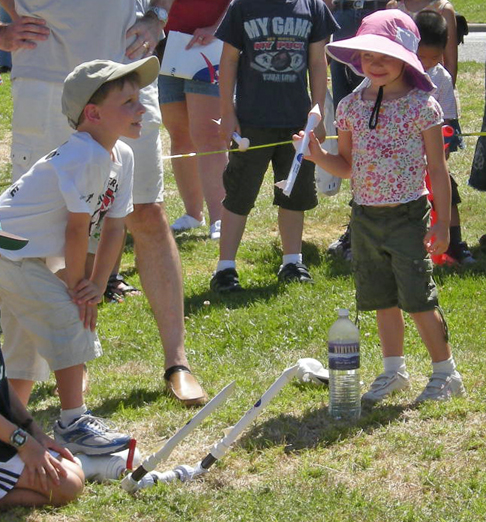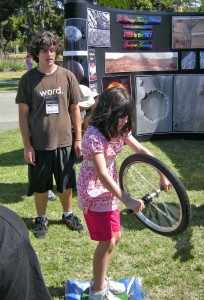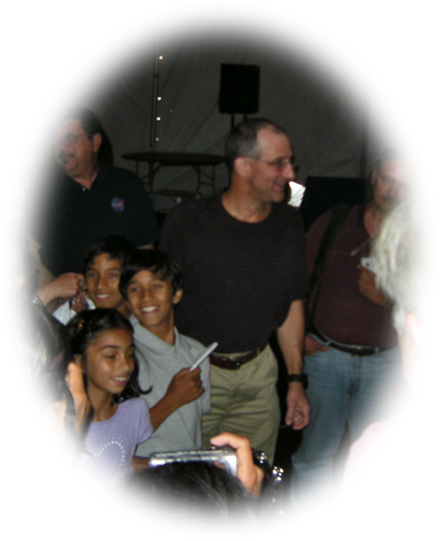Posts Tagged ‘astronauts’
Moon Fest 2009
Monday, July 20th, 2009
Yesterday I went to the Moon Fest at Ames Research Center, one of the events that NASA has organized in honor of the anniversary of the first moon landing. In every way except one, the afternoon left me very optimistic about the future of space travel.
First, one thing that impressed me was that there was a big crowd. This wasn’t “book reading at the bookstore” big or even “Friday night at the movie theater” big. It was “sports event” big, with a traffic jam waiting to get off the highway, traffic cops showing people where to park, etc. I would guess that at least a couple thousand people came. That’s pretty exciting — a couple thousand people for a science event!

Crowds at Moon Fest; Lunar Science Institute in semi-background; Hangar One in background
Of course, there were lots and lots of kids, and somewhat to my surprise there was a very well-planned choice of activities for them. They could drive robotic “moon buggies” or look through a telescope at the sun or build and launch model rockets out of paper and plastic. If your rocket landed in a “moon crater” (a big bowl-shaped piece of plastic) you would win a prize. I don’t know if the kids realized it, but this game was intended to tie in with the LCROSS mission that is currently in orbit about the moon, and will smash into a lunar crater on October 9. Here are a couple of kids getting ready to launch their rockets:

Countdown begins

The Gyroscope Effect
And here’s another girl learning about angular momentum. She is standing on a rotating platform. When she tilted the spinning bicycle wheel, the conservation of angular momentum caused her to start spinning around.
For adults or more seriously minded folks, there was also a big tent set up for lectures. I got there in time for a lecture by Tony Colaprete, the principal investigator for the LCROSS mission. I did a short interview with him afterwards, which I will write about in a future post. Again, the size of the crowd was very respectable, probably at least 300 people.
The best speaker, though, was Donald Pettit, an astronaut who has flown aboard both the Space Shuttle and the International Space Station. In fact, he was one of the astronauts who was on board the ISS when the space shuttle Columbia exploded on re-entry in 2003, and he was stranded there until he could get back home on a Russian Soyuz spacecraft. (He spent five and a half months in orbit.)

Kids love astronauts!
Astronauts are the closest thing that NASA has to rock stars. The questions after all the other talks were asked by adults, but after Donald Pettit’s talk the kids couldn’t wait to ask questions. They wanted to know how germs work in outer space, how long it takes you to get over your “sea legs” (or “space legs”) after you get back home, and how old you have to be to be an astronaut.
Pettit’s answer to that last question surprised me. He said there is no age limit, minimum or maximum. BUT most of the space shuttle and space station astronauts these days are scientists, which means they have to get a science degree and they have to make some kind of impression with their research. So the typical astronaut these days is in his or her late 30′s or early 40′s. That was older than I would have expected. By the way, I hope the kids caught the subtext of Pettit’s answer: You want to be an astronaut? Study science.
Pettit’s talk had lots of great video clips. He showed a simple gadget he invented for drinking tea in outer space, and he showed himself “eating” blobs of tea with chopsticks. He showed a film of sunrise as seen from the space station: from full darkness to full sunrise in seven and a half seconds! He showed how they recycle urine (“yesterday’s coffee”) so that you can drink it again (“today’s coffee”). His talk was light-hearted (“In space, you get to play with your food and call it science,” he said) but at the same time he did not miss any opportunities to point out that the knowledge we are gaining will be important to us as we continue to voyage in space. For example, recycling every little bit of water that we can will be vital in the nearly anhydrous environment of the moon or Mars.
Over and over, Pettit emphasized that “strange things happen at frontiers.” And that’s why we want to go to frontiers, because that is where we can discover new things and see the world in new ways.
So, as I said, I came back from the Moon Fest feeling good about space science. The public interest is real, if you can engage it. I felt as if NASA is doing wonderfully with its educational mission. In the 1960s they could never have pulled off an event like this. Also, NASA still has a corps of talented and charismatic astronauts, like Donald Pettit, who can make a passionate case for why space is important. And there is still a whole universe out there of things to be discovered.
There’s only one thing missing from this picture. You’ve got the enthusiasm, you’ve got the talent, you’ve got the unexplored frontier – but you need to have a mission. You need something for all these people to get excited about. You need a challenge that is worthy of the talents of the astronauts and the scientists and the huge support staff behind them.
The Shuttle is good … but it’s retiring soon. A couple years from now, for the first time since the 1970s, the United States won’t have any spacecraft capable of taking humans into space. The next time Donald Pettit goes into orbit, he will have to hitch a ride with the Russians. The Space Station is great … but just a little bit too ordinary. I don’t think that it inspires very many people. There’s only one mission that NASA ever had that was transcendent, and that was going to the moon.
So that’s the missing piece. All of NASA’s literature still talks about returning to the moon by 2020, but I am far from convinced that it will happen. It will take leadership to stay the course, and I still haven’t seen the proof that our current leadership is committed enough to it. But we’ll see! Hopefully, when the 50th anniversary of Neil Armstrong’s “one small step” rolls around, we will either have people on the moon or we will have plans to get them there in the very near future.